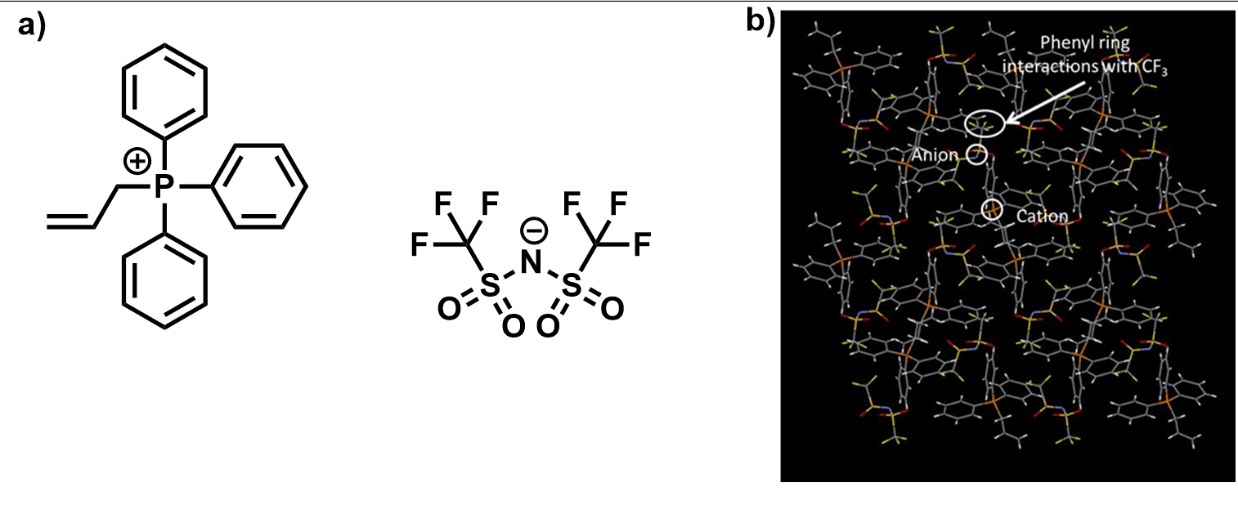Ionic liquids (ILs) are conductive liquids with no or little vapor pressure. ILs form dynamic structures within the liquid state, and these structures exist within an equilibrium at a specific condition. As the conditions change, either by exposure to external stimuli and environmental changes (humidity, gas composition, etc.), these materials’ conductivity also varies, thus providing materials-based sensors which can be fabricated into sensing devices.

Figure 1: a) chemical structure of allyltriphenylphosphium-bis(trifluoromethyl)sulfonyl)amide (AllylPh3P-TFSI). B)The crystal structure of (AllylPh3P-TFSI) shows that the phenyl rings mainly interact with the CF3 of the TSFI anion. The anion and cation are separated, creating spaces between them. AllylPh3P-TFSI was created mainly to accommodate the flow of ions through the channels. X-Ray structure was obtained by Dr. Damodaran Achary of the University of Pittsburgh
RoCo has been conducting ionic liquids research for many years for several applications, including batteries, carbon capture, polymer compatibilizer, and solvent. Figure 1 shows the chemical structure of allyltriphenylphosphium-bis(trifluoromethyl)sulfonyl)amide. This IL was specifically developed for gas absorption applications and studied extensively by the researchers at RoCo. On the right, single-crystal X-Ray data of this ionic liquid is shown. The IL here is different as the anion and cation are separated due to steric hindrance, forming ionic channels where polar gas molecules can reside and be used for sensor applications. This material can also be used as a high-temperature battery electrolyte as well.
There is significant interest in electronic skin sensors or wearable thin-film sensors. These sensors can be placed directly on the skin to measure body parameters such as body temperature, heartbeat, sweat composition, etc. These sensors are now used in various applications such as healthcare, sports, robotics and prosthetics, and the military. Ionic liquid-based skin sensors are an emerging type of pressure sensor capable of perceiving external stimuli of pressure, strain, and torsion and turning them into electrical signals. These ionic liquid sensors can be encapsulated in silicones and can be worn directly. When connected with smart devices, it effectively expands the ability of human beings to perceive and evaluate the external environment. It is essential to point out that ionic liquids can be polymerized and converted into membranes, coatings, thus further widening their applicability. When ionic material is impregnated into textile fibers, it can provide skin sensors with high permeability, wearable comfort, wears resistance, and anti-bacterial properties.
In the literature, several ionic liquids have been used for this application. 1-ethyl-3-methylimidazolium-tetrafluoroborate (EMIM BF4) has been used as a gelled electrolyte in wearable electronics. In addition to EMIM BF4, the gelled ionic liquid sensors based on a trihexyltetradecyl-phosphonium dicyanoamide have been used to evaluate real-time pH in sweat. Ionic liquid composites with carbon nanotubes and an ionic liquid ([EMIM]Tf2N) have also been used to sense surface temperature.
If you are working with ionic liquids, our knowledgeable team can support your developmental efforts by identifying the suitable ionic liquid and developing custom ionic liquid materials solutions. Contact us
